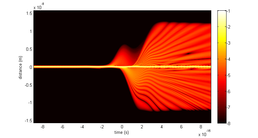Soft x-ray science on a tabletop
- Homepage
- http://www.orc.soton.ac.uk/xray.html
- Research Team
- Patrick Anderson, Arthur Degen-Knifton
- Investigators
- Peter Horak, Jeremy Frey, Bill Brocklesby

The electron density function of an individual atom encountering an ultra-intense pulse of laser light.
Bright sources of coherent extreme ultra violet (XUV) and soft x-ray (SXR) radiation have become an indispensable tool for scientists and engineers across numerous disciplines including biology, fundamental physics, chemistry and materials science. The majority of today's SXR sources are located at national facilities, where the radiation is generated within a synchrotron or free electron laser (FEL). The vast scale of these facilities means they are incredibly costly and access to visiting experimental groups is often limited to a few weeks a year. An attractive alternative to sources of this type is an elegant tabletop technique known as high harmonic generation (HHG) [1], which in its most efficient geometry involves passing ultra-intense pulses of laser light through a short length of gas filled capillary. Inside the capillary electrons get ripped away from gaseous atoms and accelerated to high velocities by the laser pulses, and upon recombination with their parent ions coherent high energy radiation is emitted in the form of SXRs.
In this project we perform the demanding computational modelling required to aid experimentalists at Southampton develop sources of bright SXR radiation using this exciting technique. The modelling comprises of two main steps: the first of which is to use a system of coupled nonlinear PDEs to investigate how intense laser pulses get distorted as they travel through a rapidly ionizing gas [2], the second is to describe the SXR generation process itself by modelling the response of an individual atom to an intense laser pulse by solving the full time dependent Schrödinger equation (TDSE) numerically. The second step in this process is incredibly computationally intensive, as finding a suitable solution requires around 30 minutes of workstation compute time, and solutions must be found at many tens of thousands of positions within the capillary. To overcome this problem we take advantage of an efficient pseudo-spectral technique, the ease at which our problem can be parallelized and the Iridis cluster to accomplish the task quickly on both CPU and GPGPU architectures.
Preliminary simulations have shown that an individual GPGPU is able to find ~150 independent solutions to the TDSE in the same time a workstation requires to solve a single equation. These early simulations have allowed experimentalists at Southampton to increase the SXR yield of their source by two orders of magnitude, making the future outcomes of this project very exciting.
REFERENCES
[1] M. Ferray, A. L'Huillier, X. F. Li, L. A. Lompre, G. Mainfray, and C. Manus, "Multiple-harmonic conversion of 1064 nm radiation in rare gases," Journal of Physics B: Atomic, Molecular and Optical Physics, vol. 21, pp. L31-L35, Feb. 1988.
[2] R. T. Chapman, T. J. Butcher, P. Horak, F. Poletti, J. G. Frey, and W. S. Brocklesby, "Modal effects on pump-pulse propagation in an Ar-filled capillary," Optics Express, vol. 18, p. 13279, June 2010.
Categories
Physical Systems and Engineering simulation: Electromagnetism, Photonics, Wave propagation
Algorithms and computational methods: FFT, Finite differences